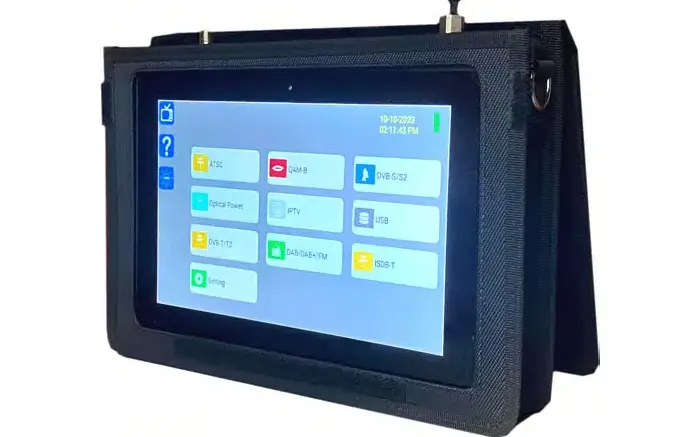The meter you see above is Toner Cable’s latest signal meter. It’s one of the least expensive and most capable devices for measuring ATSC 3.0 signals. It’s also significantly more expensive than our SignalScout ATSC 1.0 meter. Yes, Toner’s device brings more to the table, but we’re asked frequently why there isn’t a lower-priced ATSC 3.0 meter available. After all the technology for measuring ATSC 3.0 signals isn’t incredibly special. If you actually want to get a live picture, you have to pay for licenses for several patents, but even that probably isn’t too expensive.
In order to understand why ATSC 3.0 signal meters are so expensive in 2024, you have to look at the way these devices are made.
The fact: manufacturing costs aren’t the issue
It is absolutely mindboggling how inexpensive it is to actually make an electronic device. You can find incredibly capable devices on overseas web sites for well under $100. There’s a simple reason for that. The technology for making computer chips and boards is very mature. There are a lot of factories doing it. Those factories are often in foreign companies where labor is cheap and safety regulations are lax. So no, actually making the thing isn’t the real cost center. There are two other things which really make a difference in the retail price.
The biggest cost: engineering
Creating and testing a new device can cost millions of dollars, if not billions. Before the first manufacturing order is placed, a device has to be designed, thoroughly tested, and submitted for regulatory approval. Something made for US-only use only needs FCC approval, but if it’s being used worldwide it needs to go to several different global agencies, all with different requirements.
Doing all this work takes high-priced engineers working together. It takes time, and often there are engineering projects that don’t pan out. Altogether, this creates a huge fixed cost that a company needs to pass on to customers in order to stay in business. That leads to the other factor:
Manufacturing volume is a huge part of it.
When a device is new, it’s usually made in fairly small volumes. Keep in mind for this kind of manufacturing, anything under 100,000 is a small volume and anything under 10,000 is a tiny volume. The smaller the manufacturing run, the bigger the share of those engineering costs that needs to be borne by each piece. If a device costs $30 to make (which is very possible, believe it or not) it still may need to carry $150 or more in engineering costs in order for the company to stay profitable.
Large companies like Apple can forecast the lifespan of their products easily. They can estimate several production runs and spread out engineering costs over that time. That iPhone in your hand may only cost $200 to make, but it cost billions to engineer. Luckily they’ll sell billions of them so they can spread that cost out easily.
Something like an ATSC 3.0 signal meter may have only one manufacturing run of under 10,000. That means if it cost a million bucks to engineer (quite possible) each device might need to carry $100 in engineering costs. It might also carry another $100 in regulatory costs. That’s what drives costs up on small-volume electronic devices.
Is there hope for less expensive ATSC 3.0 meters?
Absolutely. We’re already seeing low-cost ATSC 3.0 converter boxes. Each one of those has a full-featured signal meter in them, whether or not it’s accessible to the user. The real breakthrough will come when demand for ATSC 3.0 is high enough to interest a major chipmaker.
There are companies out there that do nothing but create “reference designs.” They do all the engineering to make something work and then they license out those designs to multiple chip makers. Then those chip makers create “reference designs” of completed products and resell those to multiple board manufacturers. Those boards can be made at scale for very little money and when that happens, retail costs plummet.
A perfect example of this is what happened with DVRs in the early 2010s. The tech had gotten so mature that companies like Broadcom came up with general-purpose chips and reference boards that could be adapted to multiple providers. Pretty much every cable and satellite company took advantage of this so they could get new hardware out on the market. The final devices all looked different, but the tech inside was remarkably similar. What’s more, prices dropped quickly.
Does this mean you should wait on an ATSC 3.0 meter?
That’s up to you. I think most folks don’t need an ATSC 3.0 meter today. ATSC 3.0 signals are generally broadcast on the same towers as ATSC 1.0 signals. So, if you have a good ATSC 1.0 meter, you’ll be able to aim for the 3.0 signals as well. If you’re a professional, a good versatile meter is important, but home users might not need to spend the cash right now.
In the end, no matter what you decide, you’ll find what you need when you shop at Solid Signal. We have the best selection of everything you need for over-the-air, satellite, cable, and streaming television. Shop the great selection or, if you need personal service call the experts at 888-233-7563. We’re here for you during East Coast business hours. If it’s after hours, fill out the form below! We’ll get right back to you!




